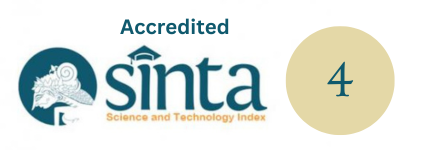Pethitan: Understanding the End Tone System in Javanese Gamelan | Pethitan: Pemahaman Sistem Nada Ujung Pada Gamelan Jawa
DOI:
https://doi.org/10.59997/jurnalsenikarawitan.v1i4.674Keywords:
pethit, Javanese gamelan, composition, karawitanAbstract
Pethitan is a new composition inspired by the system of tones found in Javanese gamelan. One of them is the end of each ricikan. This end tone is called pethit. Verbally this term is often referred to by tweeters, teachers, and researchers. However, in the notes of various documents, scientific writings, there is no comprehensive description of pethit. Hence, it is necessary to reactivate the concept through artwork research, then this artwork is titled Pethitan. The purpose of creating Pethitan's karawitan composition work is to realize the work of karawitan composition by exploring the concept of pethit. The method of art creation is an empirical method consisting of observation, discography, and literature studies. In addition, it also uses methods of building works and presentation of works. The pethit tones in this composition are explored from three different Javanese gamelan devices of basic tones. Therefore, each end tone of each device has a different frequency. This difference is a source to realize musical elements in melodies, rhythms, and composition dynamics.
Downloads
References
Ardana, I. K. (2012). Sekala Niskala: Realitas Kehidupan Dalam Dimensi Rwa Bhineda. Dewa Ruci: Jurnal Pengkajian Dan Penciptaan Seni, 8(1), 139–156. https://doi.org/10.33153/dewaruci.v8i1.1097
Ardana, I. K. (2017). Metode Penciptaan Karya-Karya Baru Karawitan Bali. In Yudiaryani, B. Pudjasworo, H. B. Prasetya, & I. W. Senen (Eds.), Karya Cipta Seni Pertunjukan (pertama, pp. 345–363). JB Publisher bekersama dengan Fakultas Seni Pertunjukan ISI Yogyakarta.
Ardana, I. K. (2021). Re-Actualization Balinese Gamelan Harmony for Renewal Knowlegde of the Balinese Music. International Journal of Creative and Arts Studies, 8(June), 51–69. https://doi.org/10.24821/ijcas.v8i1.5514
Aryanto, A. S. (2018). Gamelan Soepra: Konsep dan Perilaku Musikal untuk Mencapai Tujuan Pendidikan. Journal of Music Science, Technology, and Industry, 1(1), 111. https://doi.org/10.31091/jomsti.v1i1.507
Dewi, A. F. K., Kinanti, M., & Sulistyorini, P. (2020). Pola Barisan Aritmetika pada Pukulan Ketukan Dalam Gending Ketawang di Gamelan Yogyakarta. Seminar Nasional Pendidikan Matematika, 7–14.
Djohan. (2016). Psikologi Musik (Cetakan IV). Penerbit Indonesia Cerdas.
Hananto, F. (2020). Gamelan Sebagai Simbol Estetis Kebudayaan Masyarakat Jawa. Representamen, 6(01). https://doi.org/10.30996/representamen.v6i01.3511
Naibaho, C. A. (2015). Analisis Improvisasi Vokal Dianne Revees Pada Lagu “Triste” Karya Antonio Carlos Jobim. Saraswati: Jurnal Mahasiswa Seni Tari. https://doi.org/10.24821/srs.v0i0.969
Pradana, K. A. W., & Garwa, I. K. (2021). Samirata: Sebuah Karya Komposisi Seni Karawitan Tabuh Kreasi. Ghurnita: Jurnal Seni Karawitan, 01(03), 145–151. https://doi.org/10.25124/ghurnita.v1i1.355
Prayuda, N. (2018). Penciptaan Komposisi Musik Karawitan “ Pararaan dalam Gauangan .” Laga-Laga: Jurnal Seni Pertunjukan, 04(1), 85–96. https://doi.org/10.26887/lg.v4i1.458.g316
Priya, Y., & Janardhana, K. (2021). Kamuflase: Korelasi Intramusikal dan Ekstramusikal dalam Penciptaan Komposisi Karawitan Bali. Promusika, 4(1), 69–80.
Purwanto, D. (2017). The Role of the Gender Barung in creating the Aesthetuc of Surakarta Style Javanese Karawitan. In 1st International Conference of Arts and Creativity (ICAC).
Sandyasa, I. K. (2018). Refleksi dan Dekontruksi Teori Oposisi Biner dalam Tradisi Hindu Masyarakat Bali. Pangkaja: Jurnal Agama Hindu, 21 No 1, 6.
Santoso, I. B. (2015). Proses Amplifikasi Gamelan Jawa dalam Pergelaran Karawitan. Keteg, 15(33–41).
Supanggah, R. (2002). Bothekan Karawitan I (1st ed.). Masyarakat Seni Pertunjukan Indonesia.
Tim Penyusun. (2001). Baoesastra Djawa - 1939. Yogyakarta: Penerbit Kanisius.
Yudha, I. N., Widiantara, P., Santosa, H., & Suartaya, K. (2020). Proses Penciptaan Komposisi Karawitan Kreasi Baru Paras Paros. 8(April), 1–13. https://doi.org/10.24821/promusika.v1i1.3607








